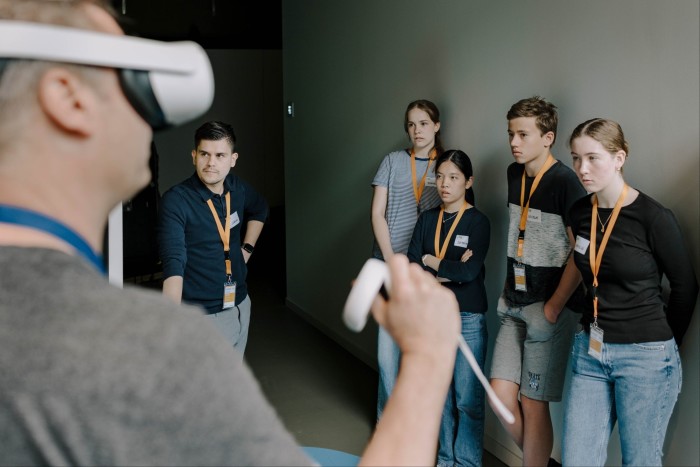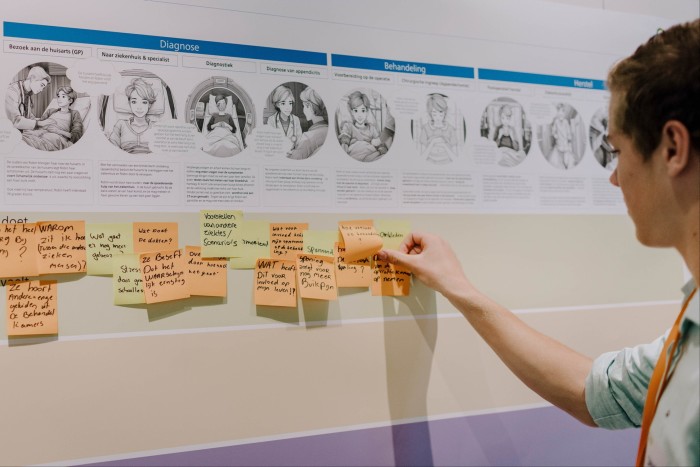In a large, airy room at the headquarters of healthcare giant Philips in Eindhoven, the Netherlands, a group of local teenagers are seriously discussing how to improve the care of “Robin” – a patient about their age who is suffering from appendicitis.
Each step of the journey, from diagnosis to recovery, is illustrated through AI-generated storyboards. But even though the scenario is fictional, this is more than just a well-intentioned but ultimately unnecessary form of public relations.
Philips aims to harness the wisdom of this cohort of digital natives ages 13 to 15 to reimagine care and identify technologies that can improve the patient experience.
“We do this because when we meet young people, we actually get a look at the future of healthcare,” says Peter Skillman, who is only the eighth global design chief in Philips’ nearly 100-year history. He proudly displays a book with photos of his predecessors to underline the legacy he inherited.
The benefit of this young group is not just that they know what the next generation of healthcare workers and patients want. It also lies in their ability to apply an open, flexible mindset and influence care in the here and now.
According to Skillman, this is a generation that expects information to be delivered quickly and in an easily digestible form. And its members lack the automatic respect for clinical authority that their parents or grandparents may have shown.
He adds: “They can change tasks very quickly and are very adaptable. So you are a user of emerging new technologies [they have a] very low inhibition threshold to try new things.”
Skillman had been struck by a comment made earlier by one of the young people, who recalled being told after a medical test to wait for a doctor to come and read the results. “She said, ‘I had to wait so long, and the doctor came in and after two minutes said, ‘Everything is fine,'” he recalls. “And she was [asking] ‘Why?’ They have no respect for the hierarchy of medical leadership. They think, ‘These people serve me.'”
Divided into groups, the young people first discuss the storyboards and explore the feelings they evoke. Certain common themes emerge: concern about what could go wrong during an operation; the desire to receive information quickly and in a way they can understand; the desire to spare their parents worry.
They are then taken to another part of the building where lead software architect Jean-Marc Huijskens introduces them to a range of cutting-edge technologies that would delight any teenager, including demonstrations of augmented and virtual reality. [AR and VR] – a simulated, immersive experience used in this case to show what it feels like to drive a car when extremely tired – and a machine that allows surgeons to see a 3D image of the heart and thus the size to determine the stent needed to keep blood vessels opening.
Back in their groups, another discussion follows before the young people present their ideas with shy pride. These include: a “care robot” to alleviate the feelings of insecurity and insecurity that young patients often feel; an AI avatar that prepares them for treatment; and a robotic “cuddly toy” to keep worried younger patients company. The alleged inventions would all use generative AI and ensure that patients have questions about their stay in the hospital answered in real time.
The young people’s ideas need to be validated by a wider group, including designers, engineers, patient groups and doctors, but past experience suggests that at least some of them could bear fruit.
Skillman cites a 2019 session in which another group of teenagers spent time in one of his innovation labs, learning how catheters are used in hospitals to perform procedures in a less invasive way than traditional surgeries.


“They said, ‘I want you to tell me immediately what happened. [during the procedure] in simple words. Don’t give me medical expertise because I don’t understand it.” Now the company is using an AI-powered program to communicate complicated medical diagnoses in simple language.
Robert-Jan de Pauw, Philips’ head of data-driven solutions, is aware that these young people are not only the patients, but also the doctors, nurses and healthcare professionals of the future. That’s why he also offers courses for people who want to pursue a clinical career. They are asked to try out existing and prototype technologies.
Building a new system, he says, “takes about seven and a half to ten years for us.” So when the system comes to market, these young people may be old enough to use it as adult medical professionals.
De Pauw points to small but significant differences that inform Philips’ design decisions based on the information gained from these meetings.
For example, he notes that when handling remote controls, “teens use their thumb, while older people tend to use their index finger. We believe it is very important to gain the insights of younger people because they are the future users of the system.”
At the end of their morning exploring health technology, two of the young people in the session observed by the FT raved about the new information and perspectives they had gained.
Diede Tyssens, 14, who is considering a career as a midwife, says she “liked being able to immerse herself in the world of medicine” because her teacher acted as an interpreter.
Her 15-year-old classmate Anuraag Nayak, who is considering biology or medicine as a future direction, says he has “learned a lot.” I didn’t even know that such things [as simulations and VR] existed”.
Since he himself recently had appendicitis, the day’s activities had a special meaning for him: “This project was quite personal,” he says.